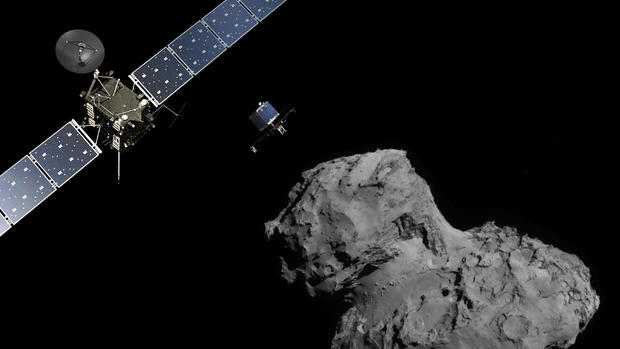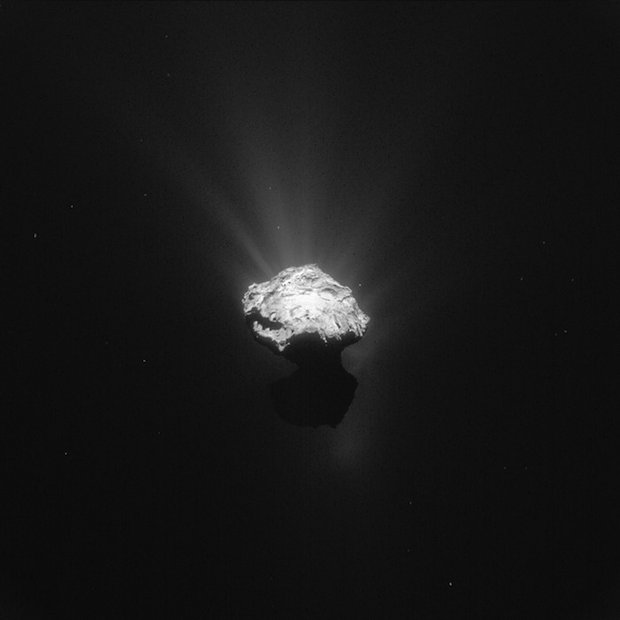Rosetta mission to study comet extended until 2016
The Rosetta spacecraft will extend its mission until September 2016, ending its journey by possibly landing on the surface of the Comet 67P/Churyumov-Gerasimenko.
Originally funded through the end of December, the mission was given another nine months to study the comet on Tuesday by the European Space Agency's Science Programme Committee. After that, as the comet moves far away from the sun again, there won't be enough solar power to run Rosetta's set of scientific instrumentation efficiently.
"This is fantastic news for science," said Matt Taylor, ESA's Rosetta Project Scientist. "We'll be able to monitor the decline in the comet's activity as we move away from the sun again, and we'll have the opportunity to fly closer to the comet to continue collecting more unique data. By comparing detailed before and after data, we'll have a much better understanding of how comets evolve during their lifetimes."
Since arriving at the comet in August 2014, Rosetta has been collecting reams of data and plenty of very cool images.
Scientists pouring over the data have been able to determine among other things that magnetic fields may not have played a critical role in the solar system's formation and that asteroids, not comets, most likely delivered the lion's share of the water making up Earth's oceans.
They have also learned a lot about the comet itself, including its overall shape (it looks like a rubber duck). They also concluded that the comet's nucleus is covered with a range of organic compounds - mostly carbon-hydrogen and/or oxygen-hydrogen chemical groups - and that its center is made of dust, rock and frozen gas.
Most of Rosetta's focus has been studying the comet's nucleus and environment, as it moves along its 6.5-year orbit closer to the sun.
To get a closer look, the lander Philae was deployed to the surface in November. But just 57 hours into its operations, it went into hibernation - only waking and making contact this past weekend after finally getting enough sunlight on its solar panels to transmit data to the Rosetta orbiter.
In the coming year, scientists are looking forward to a number of significant landmarks - including Aug. 13 when the comet makes its closest approach to the sun (known as perihelion).
They also hope to better understand how the comet's activity changes along its orbit. And as the activity drops off after passing close to the sun, scientists believe it should be possible to move the orbiter much closer to the comet's nucleus again, to make a detailed survey of changes in the comet's properties during its brief "summer."
The team also hopes to carry out several slightly riskier investigations, including flights across the night-side of the comet to observe the plasma, dust, and gas interactions in this region, and to collect dust samples ejected close to the nucleus.
Rosetta will run out of power, its propellant largely depleted, in late 2016. ESA is timing the end of the mission a few months ahead of that. Then, rather than put the spacecraft into hibernation, as was done in June 2011 for 31 months, the plan is to land the craft on the comet.
"This time, as we're riding along next to the comet, the most logical way to end the mission is to set Rosetta down on the surface," Patrick Martin, Rosetta Mission Manager, said.
"But there is still a lot to do to confirm that this end-of-mission scenario is possible," he said. "We'll first have to see what the status of the spacecraft is after perihelion and how well it is performing close to the comet, and later we will have to try and determine where on the surface we can have a touchdown."
If all goes as planed, then the spacecraft would be commanded to spiral down to the comet over a period of about three months. Scientific operations would continue, allowing Rosetta's instruments to gather unique data at unprecedentedly close distances.
But once it lands, the ESA doesn't expect it will continue operations nor have the ability to relay data back to Earth - bringing an end one of the most successful space operations ever.


